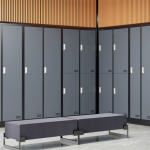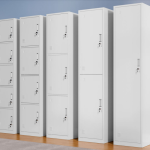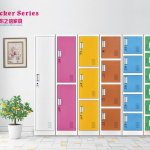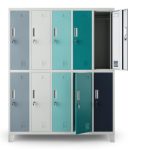Steel lockers are renowned for their durability, security, and longevity, making them a staple in schools, gyms, workplaces, and industrial facilities. However, like any heavily used piece of equipment, they are not immune to problems. From minor annoyances to major functional failures, understanding these common issues is the first step in preventing them and ensuring your lockers have a long service life.
Here are the most frequent problems associated with steel lockers and what you can do about them.
1. Sticking, Jamming, or Broken Locks
This is perhaps the most common and frustrating locker issue.
The Problem: A user cannot open their locker because the key won't turn, the combination won't align, or the latch is stuck. In severe cases, the internal mechanism can break entirely.
Causes:
- General Wear and Tear: Over thousands of cycles, internal tumblers and springs can wear out.
- Dirt and Debris: Dust, grime, and even spilled liquids can gum up the locking mechanism.
- Forced Entry Attempts: Vandalism or attempts to pry the lock can damage the internal components.
- Misalignment: If the locker door or frame is bent, the bolt may not align correctly with the strike plate.
Solutions:
- For stuck key locks, a quick spray of a graphite-based lubricant (not oil, which attracts more dirt) can often free the mechanism.
- For combination locks, ensure the dial is being turned correctly and completely.
- If the locker is misaligned, a maintenance technician may need to adjust the door hinges or the strike plate.
- For broken mechanisms, replacement is usually the only option.
2. Rust and Corrosion
While steel is strong, it is susceptible to oxidation, especially in certain environments.
The Problem: Unsightly brown or orange spots appear on the locker's surface, which can eventually lead to holes and structural weakness.
Causes:
- High Humidity: Locker rooms in gyms and pools are prime locations for rust due to constant moisture.
- Scratches and Chips: Damage to the powder-coated finish exposes the raw steel underneath to moisture and air.
- Harsh Chemicals: Exposure to cleaning agents or industrial chemicals can break down the protective coating.
Solutions:
- Prevention is Key: Specify lockers with a high-quality powder-coat finish for humid areas. For pools or chemical plants, stainless steel or lockers with epoxy coatings are far more resistant.
- Touch-Up Kits: For minor scratches, use a manufacturer-provided touch-up paint pen to seal the exposed metal immediately.
- Regular Cleaning: Wipe down lockers with a dry cloth and ensure the room is well-ventilated to reduce moisture buildup.
3. Stuck or Damaged Doors and Drawers
A locker that won't open or close properly is a major inconvenience.
The Problem: The door drags on the frame, doesn't latch securely, or a drawer gets stuck on its rails.
Causes:
- Bent Frames or Doors: Often caused by impact from carts, overstuffing, or slamming.
- Worn or Loose Hinges: Hinges can become loose over time, causing the door to sag.
- Obstructions: Items inside the locker can fall and jam against the door.
Solutions:
- Check for and remove any visible obstructions.
- Tighten any loose hinge screws.
- If the frame is bent, it may require professional repair to realign the door. Forcing it will only cause more damage.
4. Dents, Scratches, and General Wear
This affects the locker's appearance and can lead to more serious issues like rust.
The Problem: The locker surface becomes marred with dents, scuffs, and scratches.
Causes: Daily use, abuse, being hit with equipment (like sports gear or tools), and general neglect.
Solutions:
- Choose a locker with a thicker steel gauge (e.g., 12 or 14 gauge) for high-traffic or industrial areas, as it is more resistant to denting.
- Lockers with a textured finish are better at hiding minor scuffs and scratches.
- Implement clear rules against slamming locker doors and overloading them.
5. Poor Ventilation and Odors
This is a common complaint in gym and sports lockers.
The Problem: A damp, musty smell emanates from the locker, often caused by sweaty clothes or damp towels that cannot dry out.
Causes: Solid-door lockers trap moisture and air inside, creating a perfect environment for mildew and bacteria.
Solutions:
- For environments where wet items are stored, always choose ventilated lockers with slotted doors and/or perforated backs. This allows for crucial airflow, drying contents and preventing odors.
- Encourage users to take their wet items home daily.
- Regular cleaning and disinfecting of the locker interior is essential.
6. Lack of Security
The primary purpose of a locker is to secure belongings, but this can be compromised.
The Problem: The locker is easily compromised, leading to theft.
Causes:
- Weak Latches: Flimsy latches can be pried open with a screwdriver.
- Poor-Quality Locks: Inexpensive locks are easier to pick or break.
- Poor Installation: A locker bank that is not securely anchored to the wall or floor can be tipped over.
Solutions:
- Invest in lockers with heavy-duty, reinforced latches.
- Choose high-security locking mechanisms (e.g., Medeco® locks) for high-risk areas.
- Ensure lockers are professionally installed and securely anchored.
Conclusion: Proactive Maintenance is Key
Most common steel locker problems are manageable and often preventable. The key is a proactive approach:
- Choose the Right Locker for the Environment: Don't use a basic school locker in a humid pool area.
- Invest in Quality: Higher-gauge steel and a superior finish cost more upfront but save significantly on maintenance and replacement costs.
- Perform Regular Inspections: Check for loose hinges, minor rust spots, and misaligned doors before they become major issues.
- Educate Users: Simple guidelines on proper use can drastically reduce damage.
By understanding these common pitfalls, you can ensure your steel lockers remain functional, secure, and presentable for years to come.





